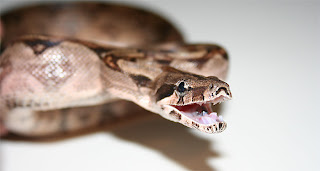Today's post is about El Salvador Boas. After holding one of these beautiful animals I thought I would research and write about them. The great thing about this type of boa is the fact that they do not grow too big as they are a type of dwarf boa and are quite active. El Salvador Boas would be perfect for keepers that don't want a sand boa as they hide all the time and also for those who don't want a large snake.
El Salvador Boas live between the evergreen rainforest and the savannah belt in Central America. The snakes thrives in subtropical climates with high temperatures of 30° C with nighttime temperatures of 16° C. As for length they can slightly exceed 4.9ft although this is not common. Humidity should be 55% although can be increased to 70% when the animal is in shed.
 |
| El Salvador Boa |
Size
It is important to ensure that you buy El Salvador Boas from a reputable seller to ensure the bloodline is pure as these boas can be cross-bred and if that is the case a buyer can end up with a much larger animal than they expected. This type of snake makes a good animal to keep as a pet due to their small size and docile temperament. They also feed well which is always a good thing. I myself would love to add one of these snakes to my collection one day and I would recommend them for a first time snake keeper.
Housing
When it comes to housing, size is important as this can effect the health of your animal. Generally El Salvador boas would need a 3ft by 2ft enclosure. They also require a warm and cold hide, water dish at all times and substrate. Heating is also essential and this can be achieved using either a heat mat or ceramic bulb which should be set to 30° C with a thermostat.
 |
| El Salvador Boa |
Feeding
Feeding is a large part of keeping reptiles and this type of snake feeds on rats of appropriate size. When selecting prey items for your snake, ensure that it is no bigger than 1.5 times the width of the snake. Generally an adult snake would eat a frozen thawed rodent once every 7 to 10 days.
Shedding
Boas generally have few problems when shedding their skin. To help the shedding process (if your snake is having difficulty) you can increase the humidity in the tank to 70% by adding sphagnum moss and or spraying the snake with clean, fresh water. It is best to start increasing the humidity when your animal goes into the blue phase. You can also increase the size of the water bowl. Problem sheds can also be eased off by allowing the snake to soak in a luke warm bath for 10-15 minutes.
 |
| El Salvador Boa |
Morphs
The colours of this snake are not as varied as other snakes such as royal pythons.
El Salvador's are greyish, brown in colour and have a considerable
number of saddle patches that fuse together on it's body. Their tails
are rusty brown and a similar patch is often found on the animals neck.
Further links of interest may include the Boidae family.
Further links of interest may include the Boidae family.
No comments:
Post a Comment
Please leave a comment.